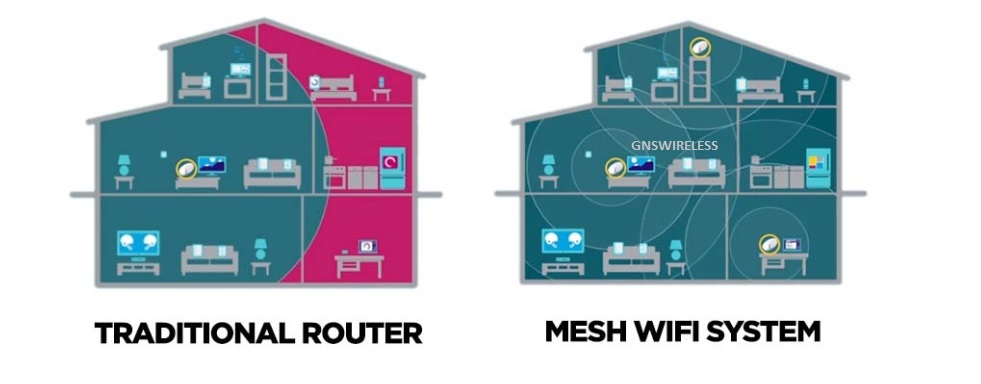A mesh Wi-Fi network is a modern approach to wireless networking designed to address the limitations of traditional router setups, particularly in terms of coverage and reliability. Here’s an explanation of what a mesh Wi-Fi network is and how it differs from traditional setups:
Traditional Router Setup:
-
Single Point of Access:
- In a traditional router setup, there’s typically a single router that serves as the central point of access for all connected devices.
-
Limited Coverage:
- Traditional routers may struggle to provide consistent coverage throughout larger homes, especially in multi-story buildings or areas with many walls and obstacles. This can result in “dead zones” where Wi-Fi signals are weak or nonexistent.
-
Single Broadcast Radius:
- The Wi-Fi signal strength diminishes as you move farther away from the router, and interference from walls and other electronic devices can further degrade performance.
-
Network Congestion:
- In scenarios with a high number of connected devices or multiple users, traditional routers may experience congestion, leading to slower speeds and less reliable connections.
Mesh Wi-Fi Network:
-
Multiple Nodes or Points:
- A mesh Wi-Fi network consists of multiple nodes or access points that work together to create a unified, expansive wireless network. These nodes communicate with each other to provide seamless coverage.
-
Extended Coverage:
- Mesh networks eliminate the limitations of traditional setups by extending coverage across a broader area. Nodes can be strategically placed to ensure a strong Wi-Fi signal in every corner of the home or office.
-
Self-Healing Capability:
- One of the key features of mesh networks is their self-healing capability. If one node fails or experiences interference, the other nodes automatically reroute data, ensuring a reliable and uninterrupted connection.
-
Intelligent Routing:
- Mesh systems use intelligent routing algorithms to optimize data pathways. Devices can seamlessly switch between nodes without users experiencing disruptions, resulting in a smoother and more consistent experience.
-
Adaptive Performance:
- Mesh networks adapt to changes in the environment and network load. This adaptability ensures that the system maintains optimal performance, even as the number of connected devices or the layout of the space changes.
-
User-Friendly Setup:
- Many mesh Wi-Fi systems come with user-friendly apps that simplify the setup process. Users can easily add new nodes to the network, monitor performance, and manage connected devices.
A mesh Wi-Fi network employs multiple nodes to create a flexible and robust wireless infrastructure, offering extended coverage, self-healing capabilities, and adaptability that traditional routers often struggle to provide. This makes mesh networks an ideal solution for larger homes, multi-story buildings, or environments with diverse connectivity needs.
The use of multiple nodes or access points in a mesh Wi-Fi network is a key feature that distinguishes it from traditional router setups. This approach is designed to overcome the limitations of a single point of access and extend Wi-Fi coverage seamlessly. Here’s a closer look at how multiple nodes collaborate to create a robust and extended Wi-Fi network:
1. Node Placement:
- In a mesh Wi-Fi system, multiple nodes or access points are strategically placed throughout the home or office. These nodes work together to create a network that blankets the entire space with Wi-Fi coverage.
2. Interconnected Nodes:
- Nodes in a mesh network communicate with each other, forming a self-organizing and self-healing network. This means that even if one node experiences issues or goes offline, the other nodes can adapt and reroute data to maintain a continuous connection.
3. Seamless Roaming:
- Devices connected to a mesh network can seamlessly roam between nodes without experiencing interruptions. As users move from one part of the space to another, the system automatically directs the device to connect to the nearest and strongest node, ensuring a consistent and reliable connection.
4. Dynamic Routing:
- Mesh networks use dynamic routing algorithms to determine the most efficient path for data transmission. This adaptability optimizes the network’s performance in real-time, adjusting to changes in the environment or network load.
5. Extended Coverage:
- By distributing nodes strategically, mesh networks eliminate Wi-Fi dead zones that may exist in larger homes or spaces with challenging layouts. Each node contributes to extending the coverage, creating a seamless and consistent Wi-Fi experience throughout the entire area.
6. Scalability:
- Mesh Wi-Fi networks are scalable, allowing users to add more nodes as needed. This makes it easy to expand coverage or accommodate an increasing number of connected devices without the need for a complete overhaul of the network infrastructure.
7. User-Friendly Management:
- Many mesh Wi-Fi systems come with user-friendly management interfaces, typically in the form of mobile apps. These apps allow users to monitor the performance of the network, add new nodes, configure settings, and manage connected devices with ease.
8. Reduced Interference:
- With multiple nodes distributing the load, mesh networks can reduce interference and congestion, especially in areas with a high concentration of connected devices. This leads to improved overall network performance.
9. Adaptive Network Optimization:
- Mesh networks continuously optimize themselves based on environmental changes and network demands. This adaptability ensures that the network operates efficiently, delivering optimal performance in various conditions.
In summary, the collaborative efforts of multiple nodes in a mesh Wi-Fi network create a flexible and resilient infrastructure. This approach not only extends coverage but also enhances the overall reliability, adaptability, and user experience, making mesh networks well-suited for diverse connectivity needs in homes and businesses.


